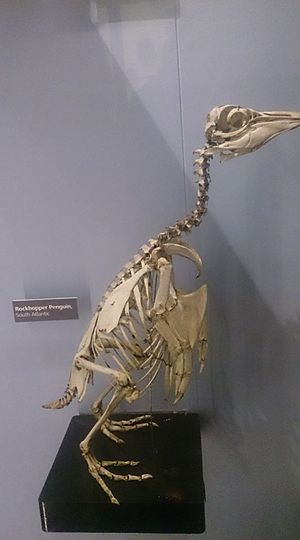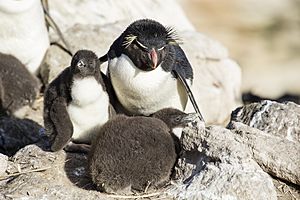Rockhopper penguin facts for kids
The rockhopper penguins are three closely related crested penguins that were thought to be a single species. They are now usually split into two or three species.
Not all experts agree on the classification of these penguins. Some think all three are distinct species. Some split the western and eastern forms into the southern rockhopper penguin and keeping the northern rockhopper as distinct, while other experts lump all three, calling it simply 'rockhopper penguin'.
- Western rockhopper penguin, Eudyptes chrysocome chrysocome
- Eastern rockhopper penguin, Eudyptes chrysocome filholi
- Northern rockhopper penguin, Eudyptes moseleyi
They have a crest of feathers on their heads. They are called rockhopper because they hop from rock to rock to their nesting places. They keep both feet together so they can jump up more than a metre.
Although the rockhopper penguin is one of the world’s most numerous penguins, the population has dropped almost 90% since the early 20th century. The cause of this decline is mainly unknown. Scientists speculate that humans are involved, mostly by commercial overfishing, oil exploitation, and pollution.
Appearance
Rockhopper penguins are among the smaller species of penguin. They range from 3 inches to 6 where males are larger than females. After reaching full growth, they are about 20 inches in height. Males and females cannot be distinguished just by looks, so a DNA test is conducted by taking a feather from the bird to determine its gender. Like many penguins, rockhopper penguins have a white belly and the rest of their body is black. Some characteristics that differentiate them from the other penguins are their red eyes, orange beak, pink webbed feet, and the yellow and black spiky feathers they have on their head. Although their yellow and black spiky feathers differentiate them from other penguins, rockhopper penguin chicks do not have them; these feathers develop with age. Their orange beak is initially black, but as the penguins get older, their beaks turn orange. Due to the harsh rocky environment, they cannot slide on their bellies like most penguins, so they hop to get from one place to another.
Subspecies
What separates rockhopper penguins into subspecies is their location of reproduction and reproductive behaviors. The difference in mating signals found between the subspecies E. chrysocome (southern) and E. moseleyi (northern) seems to have occurred quickly, thus these behavioral changes are enough to isolate these taxa.
Southern Rockhopper penguins are split into two subspecies and they are defined by their location of reproduction. The subspecies E. c. filholi (eastern) is known to reproduce in the sub-Antarctic around the Prince Edward Islands, Crozet Islands, Kerguelen Islands, Heard Island, Macquarie Island and Campbell, Auckland and Antipodes Islands. The subspecies E. c. chrysocome, which may be referred to the true southern subspecies, reproduces at offshore islands in southern Chile, Argentina and at the Falkland Islands. The Falkland Islands are known to have one of the largest populations of Southern Rockhopper penguins.
The subspecies in the group are:
- Southern rockhopper penguin, Eudyptes (chrysocome) chrysocome
- Eastern rockhopper penguin, Eudyptes (chrysocome) filholi
- Northern rockhopper penguin, Eudyptes (chrysocome) moseleyi
Habitat and distribution

Northern rockhopper penguins breed in cool temperate climates including on the islands of Gough and Tristan de Cunha in the Atlantic Ocean and St. Paul and Manchester in the Indian Ocean. The southern rockhopper breeds on the Falkland Islands, Argentina and Chile, with breeding colonies around Cape Horn in South America, and Prince Edward, Marion, Crozet, Kerguelen, Heard, Macquarie, Campbell, Auckland and Antipodes Islands in the southern Indian Ocean. Eastern rockhopper penguins are mostly found breeding on Campbell Island in New Zealand, but their numbers have declined immensely. . Rockhopper penguins usually make their habitat in rocky shorelines. They make nests and burrows in tall grasses called tussocks.
Diet
The rockhopper penguin’s diet consists of krill and small crustaceans, which may include shrimp, crabs, lobsters or crayfish. They also eat squid and myctophid fish. Rockhopper penguins consume more krill than they do fish; their diet changes during migration and as the seasons change. Rockhopper penguins can be at sea for several days while hunting. They can dive up to 330 feet (100 m) for many minutes at a time while searching for prey.
Reproduction
Rockhoppers are the most widespread crested penguins. Their range goes from the Antarctic front to the South Atlantic and Indian Oceans. Because of how widespread they are, breeding varies among the penguins in different areas. Northern Penguins begin the mating process two months earlier than Southern ones. Two eggs are usually laid a few days apart during early November in hope that at least one will survive, and the second egg is usually larger than the first. They will use the same nest as they did in previous years as well. Eggs hatch about a month later and the mother will have food for the chick.
Images for kids
-
Southern rockhopper penguin, Eudyptes (chrysocome) chrysocome, New Island, Falkland Islands
-
Northern rockhopper penguin, Eudyptes (chrysocome) moseleyi
-
Eastern rockhopper penguin, Eudyptes (chrysocome) filholi






